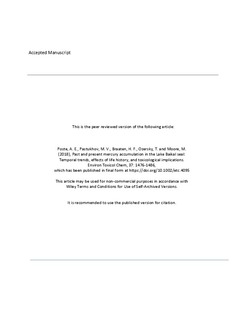| dc.contributor.author | Poste, Amanda | |
| dc.contributor.author | Pastukhov, Mikhail V. | |
| dc.contributor.author | Braaten, Hans Fredrik Veiteberg | |
| dc.contributor.author | Ozersky, Ted | |
| dc.contributor.author | Moore, Marianne | |
| dc.date.accessioned | 2019-05-29T08:26:30Z | |
| dc.date.available | 2019-05-29T08:26:30Z | |
| dc.date.created | 2018-02-12T11:08:23Z | |
| dc.date.issued | 2018 | |
| dc.identifier.citation | Environmental Toxicology and Chemistry. 2018, 37 (5), 1476-1486. | nb_NO |
| dc.identifier.issn | 0730-7268 | |
| dc.identifier.uri | http://hdl.handle.net/11250/2599369 | |
| dc.description.abstract | Despite global efforts to reduce anthropogenic mercury (Hg) emissions, the timescale and degree to which Hg concentrations in the environment and biota respond to decreased emissions remain challenging to assess or predict. In the present study we characterize long‐term trends and life‐history patterns in Hg accumulation and toxicological implications of Hg contamination for a freshwater seal from one of the world's largest lakes (Lake Baikal, Siberia, Russia) using contemporary tissues and archival teeth. Stable isotope analysis and Hg analyses of soft tissues (muscle, liver, kidney, blood, brain, heart) and teeth from 22 contemporary seals revealed rapid changes in diet and Hg accumulation in the first year of life with a stable diet and increase in tissue Hg throughout the rest of life. Although maternal transfer of Hg was an important source of Hg to seal pups, reproduction and lactation by female seals did not appear to result in sex‐related differences in Hg concentrations or age‐related accumulation in adult seals. Based on Hg analysis of archival teeth (n = 114) and reconstructed values for soft tissues, we also assessed temporal trends in seal Hg between the years 1960 and 2013. Seal Hg concentrations in hard (teeth) and soft (e.g., muscle, liver) tissues were highest in the 1960s and 1970s, followed by a decrease. The decline in seal Hg concentrations in recent decades was most likely driven by a reduction in Hg inputs to the lake, suggesting that global and regional efforts to reduce Hg emissions have been successful at reducing ecosystem and human health risks posed by Hg in Lake Baikal. | nb_NO |
| dc.language.iso | eng | nb_NO |
| dc.publisher | Wiley | nb_NO |
| dc.title | Past and present mercury accumulation in the Lake Baikal seal: Temporal trends, effects of life history, and toxicological implications | nb_NO |
| dc.type | Journal article | nb_NO |
| dc.type | Peer reviewed | nb_NO |
| dc.description.version | acceptedVersion | nb_NO |
| dc.source.pagenumber | 1476-1486 | nb_NO |
| dc.source.volume | 37 | nb_NO |
| dc.source.journal | Environmental Toxicology and Chemistry | nb_NO |
| dc.source.issue | 5 | nb_NO |
| dc.identifier.doi | 10.1002/etc.4095 | |
| dc.identifier.cristin | 1564278 | |
| dc.relation.project | Norges forskningsråd: 243644 | nb_NO |
| cristin.unitcode | 7464,30,12,0 | |
| cristin.unitcode | 7464,30,23,0 | |
| cristin.unitname | Akvatiske miljøgifter | |
| cristin.unitname | Nedbørfeltprosesser | |
| cristin.ispublished | true | |
| cristin.fulltext | postprint | |
| cristin.qualitycode | 2 | |
